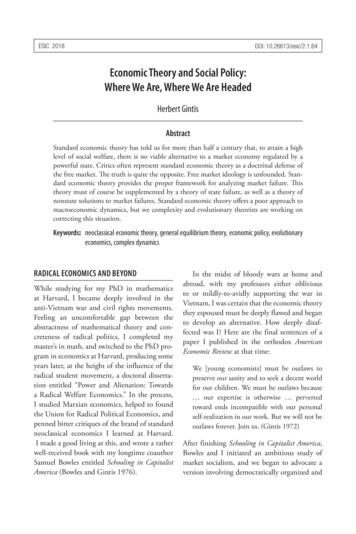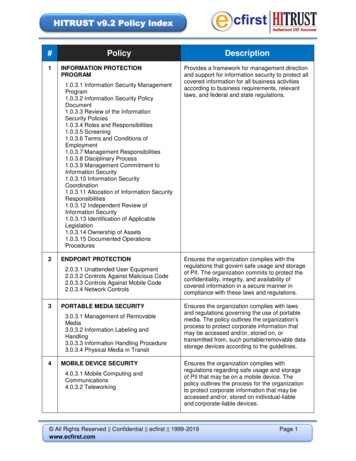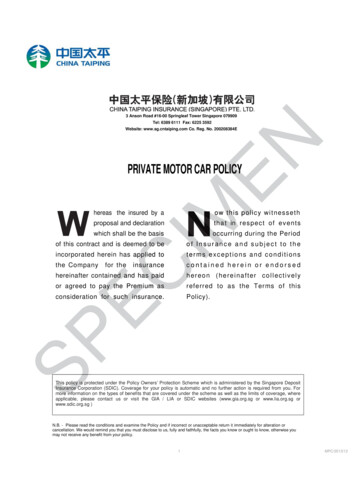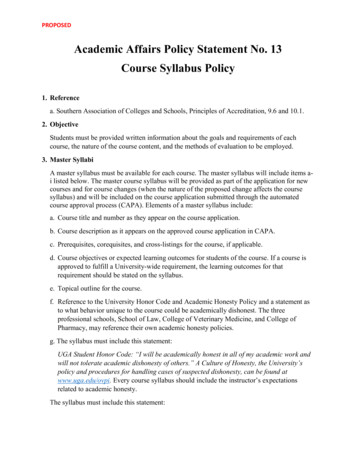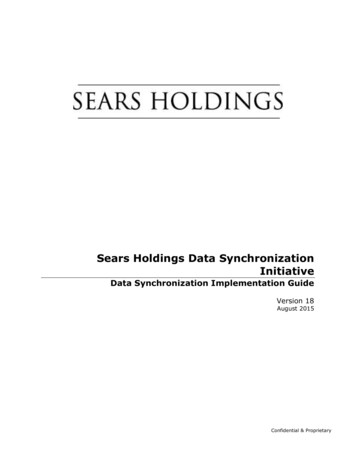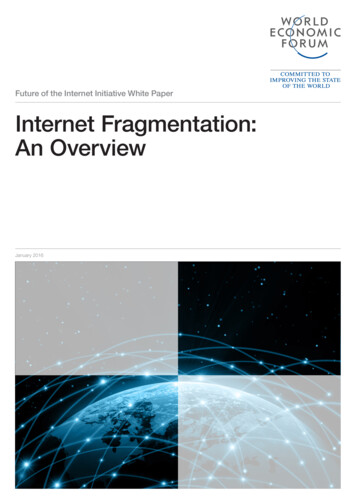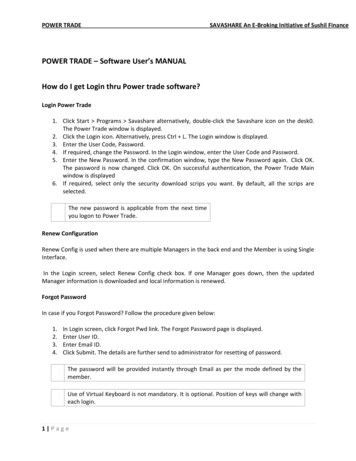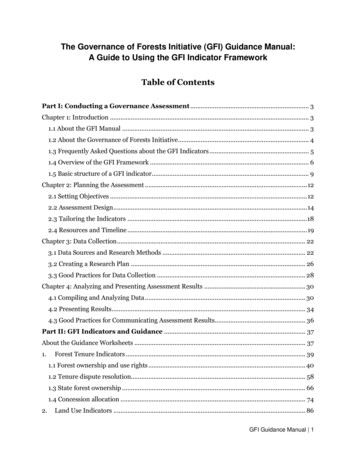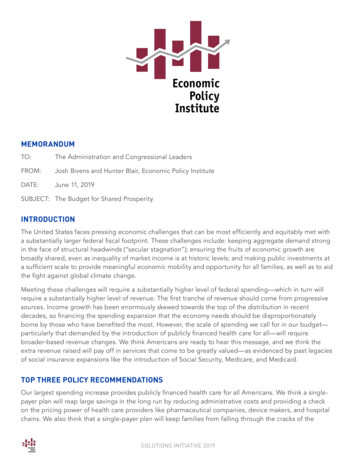
Transcription
MEMORANDUMTO:The Administration and Congressional LeadersFROM:Josh Bivens and Hunter Blair, Economic Policy InstituteDATE:June 11, 2019SUBJECT: The Budget for Shared ProsperityINTRODUCTIONThe United States faces pressing economic challenges that can be most efficiently and equitably met witha substantially larger federal fiscal footprint. These challenges include: keeping aggregate demand strongin the face of structural headwinds (“secular stagnation”); ensuring the fruits of economic growth arebroadly shared, even as inequality of market income is at historic levels; and making public investments ata sufficient scale to provide meaningful economic mobility and opportunity for all families, as well as to aidthe fight against global climate change.Meeting these challenges will require a substantially higher level of federal spending—which in turn willrequire a substantially higher level of revenue. The first tranche of revenue should come from progressivesources. Income growth has been enormously skewed towards the top of the distribution in recentdecades, so financing the spending expansion that the economy needs should be disproportionatelyborne by those who have benefited the most. However, the scale of spending we call for in our budget—particularly that demanded by the introduction of publicly financed health care for all—will requirebroader-based revenue changes. We think Americans are ready to hear this message, and we think theextra revenue raised will pay off in services that come to be greatly valued—as evidenced by past legaciesof social insurance expansions like the introduction of Social Security, Medicare, and Medicaid.TOP THREE POLICY RECOMMENDATIONSOur largest spending increase provides publicly financed health care for all Americans. We think a singlepayer plan will reap large savings in the long run by reducing administrative costs and providing a checkon the pricing power of health care providers like pharmaceutical companies, device makers, and hospitalchains. We also think that a single-payer plan will keep families from falling through the cracks of theSOLUTIONS INITIATIVE 2019
current system and provide everybody the fundamental right to health care that does not make thempoorer throughout the rest of their lives. We target two specific taxes for this expansion: a broad-basedpayroll tax and an income-based premium. These taxes will largely mimic the spending flows that financehow Americans with employer-sponsored insurance today finance their health care.On overall revenue, we recommend boosting the effective tax rate on capital income (income accruingto households through their ownership of wealth) and the abolition of all tax expenditures except for theearned income tax credit (EITC). Incomes at the top of the income distribution are dominated by capitalbased sources, and current law taxes capital very lightly—keeping households at the top from contributingtheir proper share to financing the federal budget. Effectively taxing capital will require the full suite oftax changes in our budget—there is no single silver bullet. The fiscal cost of tax expenditures today rivalsthe entire discretionary portion of the federal budget, and their benefits accrue to the richest fifth of theincome distribution. Moreover, the 2017 tax law further increased their regressivity. Many of the socialobjectives that provide the rationale for tax expenditures can be better served by direct spending. Wemodel this by replacing the child tax credit with a universal child allowance—a change that will radicallyreduce child poverty.Finally, we call for a large expansion of public investment—in traditional infrastructure, in greeninvestments, and in public education. Federal investment has been squeezed for years, and privateinvestment has been relatively weak for nearly two decades, leading to a slowdown in economy-wideproductivity growth. The most direct tool to reverse these adverse trends is a substantial boost to publicinvestments.These recommendations to raise revenue progressively and boost spending will also provide strong“balanced budget multiplier” effects to aggregate demand growth, helping the economy escape thechronic shortfall of spending that has held back growth for more than a decade.SHORTER-TERM ISSUESWe would replace current caps on discretionary spending after 2019 with permanent increases in thisspending that hold it constant as a share of gross domestic product (GDP). Our recommendation for thestatutory debt limit is to abolish it. It serves no useful economic purpose and only allows irresponsibleactors in Congress to cause economic uncertainty for political gain when it threatens to bind. We wouldcompletely undo the 2017 Tax Cuts and Jobs Act (TCJA) and replace it with the tax provisions in thisbudget. While we raise the federal gas tax in part to forestall the exhaustion of the Highway Trust Fund(HITF), we also finance other infrastructure spending with general revenue. Finally, we would authorize thepayment of Medicare Part A services with general revenue in the event of the HITF exhaustion.CONCLUSIONIn recent decades, American economic growth has been too slow and too skewed towards the rich. Thisslow and unequal growth has caused great—and unnecessary—economic distress for the vast majorityof American families. A much-larger footprint of federal spending and revenue can make a substantialcontribution to fixing the problems of slow and unequal growth. It can do this by boosting publicinvestments to make up for years of slow federal investment and the slowdown in private-sector investmentgrowth. These public investments can boost economy-wide productivity growth, as well as providemeaningful pathways for economic mobility and opportunity. Additionally, the federal government’s takingon the task of financing health care will provide great benefits to American families, both in access toSOLUTIONS INITIATIVE 2019
health care—a fundamental human right—as well as to reducing costs and wringing out inefficiencies andcorporate rents. Health care currently accounts for roughly a sixth of the entire U.S. economy, and per unithealth costs are routinely twice as high as in other advanced economies. Fundamental reform in this sectoris a crucially important economic issue for American families.Financing these increases in spending in a macroeconomically responsible way requires substantial newrevenue. But the U.S. is a rich country that is very lightly taxed relative to international peers. Further,effective tax rates on the richest households have fallen in recent decades, even as their share of nationalincome rose enormously. In short, the U.S. has enormous untapped fiscal capacity to give its residents theeconomic security and opportunity they deserve.SOLUTIONS INITIATIVE 2019
A BUDGET FOR SHARED PROSPERITYEconomic Policy InstituteJosh Bivens and Hunter BlairINTRODUCTIONEPI’s budget plan is informed by a number of stylized facts about the U.S. economy. First, economicgrowth has been slow for almost two decades. The roots of this slow growth are too-slack aggregatedemand for most of this period, anemic growth in private-sector investment, and productivity growth.Second, the slow growth in recent decades has not been accompanied by any progress at all in reversingthe huge upward redistribution of income that characterized previous decades—in fact, by many measuresinequality has continued to rise. Third, the public sector footprint in the United States is far smaller than inmany other rich countries around the world. This small public sector footprint in turn means that we expendfar less fiscal effort in income support programs to fight poverty, social insurance programs to providebroad-based economic security, and public investments to spur growth. Fourth, the most-glaring outcomeof the small public footprint in the U.S. economy is a health sector that is inefficient and unfair. Our healthcare system provides coverage to a smaller share of our population, delivers less health care, obtains worsehealth outcomes, and yet places a far greater economic burden on households than in almost any otherrich country. Given the enormous economic heft of the health care system, any budget aiming to boostliving standards must provide strong reform for this sector.A greater commitment to providing stronger public investment, social insurance and safety nets overthe long-run requires a willingness to pay more in taxes. The enormous upward distribution of income inrecent decades means we can get a long way with explicitly progressive tax increases. But our adoptionof a fully-public health care financing system is expensive enough in fiscal terms to require broader-basedtax increases. It is important to note that these broad-based taxes are not a new “cost” to households forhealthcare. Instead, they will largely replace the current health costs these households face. In the longrun, much evidence indicates that the pace of health care cost growth—and hence the economic burdenit places on families—can be substantially reduced with a fully public plan. So, even as the fiscal cost ofhealth and tax rates facing families rises, these families’ post-tax, post-health care living standards willincrease.SOLUTIONS INITIATIVE 2019
Our plan would address the slow pace of economic growth in two broad ways. First, the larger publicfootprint and a tax and transfer system that redistributes away from the top and towards the bottom andmiddle will mechanically help strengthen aggregate demand growth (as households at the top of theincome distribution save more than those in the middle and bottom). Second, because the slow paceof private investment has held back growth in recent years, our plan ramps up public investment. Muchresearch shows that investing in basic infrastructure, green infrastructure, and in early childhood careand investment would have profound effects in boosting growth for the future. Reducing inequality andramping up public investment in early childhood care and education will also provide a huge spur toeconomic mobility and opportunity.What’s the Political Opportunity for this Budget?This is obviously not a budget that many current members of the Republican party in Congress wouldsupport. But Congress has failed to even pass a budget resolution in 6 of the last 8 years, in eitherRepublican or Democratic-controlled Congresses. The extreme polarization of politics means that astrategy of finding votes in the middle of both parties by figuring out which policies code as “centrist”is obsolete, for good or bad. So, our budget is not one that has a micro-targeting political strategyof bundling together a few votes here and there to become law. Instead, it is a budget blueprint for aprogressive governing majority, should one ever take power.That said, there are elements of the budget that are broadly popular across the public who identify aseither Republican or Democratic. The most popular aspects might surprise those in the DC policymakingbubble: substantially raising taxes on the rich and corporations. A Fox News Poll found that 54 percentof Republicans favored a proposal to raise income taxes on rich families. Perhaps the most-crippling falseimpression in Beltway politics today is the reluctance to make full-throated calls for progressive taxes.There are many good reasons to undertake these progressive tax changes, and the public is broadly onboard.SPENDINGAll policies are assumed to start at the beginning of 2020. The largest practical implementation challengeis posed by our M4A program, which would need to be integrated with Medicaid and Medicare over timeinto a more-seamless public plan. The substantial increase in taxation—including new forms of taxationsuch as a wealth tax - will present the challenge of increased incentives for tax avoidance. Our plandeals with this by ensuring a broad base of taxation, for example the repeal of tax expenditures, as wellas including a substantial increase to IRS funding to ensure that the IRS has the resources necessary toenforce the new tax code.Overall, our spending proposals raise the federal government’s spending by roughly 10.1 percentagepoints of GDP in 2029 relative to baseline, and raise them by 7.9 percentage points in 2049.Medicare, Medicaid, and Other Federal Health ProgramsIn our plan, we propose to raise enough revenue to supplant all private health insurance coverage witha new public plan (a plan we’ll call M4A). We will keep the existing structure of Medicaid and Medicarein place and introduce a public plan that covers all non-elderly, non-poor households who are currentlycovered by employer-sponsored insurance or insurance purchased on individual marketplaces or who areuninsured. We will keep intact military and VA plans.We have obviously not accounted for all implementation details in this plan—such an ambitiousrestructuring of the American health system would take many years to complete. But we have tried toSOLUTIONS INITIATIVE 2019
specify where we think the financing flows of this plan would come from, and, have identified evidence asto why we think such a plan would considerably reduce the trajectory of health costs over time. We wouldalso hope to over time integrate M4A, Medicaid and Medicare into a more-seamless public plan with acommon payment structure and reimbursement rates.Essentially, we call for raising enough revenue to supplant the 6.5 percent of GDP currently spent onprivate health insurance, as well as covering the currently un- and underinsured and reducing out-of-pocketcosts system-wide by half. Given that a large share of these out-of-pocket costs is paid by current Medicarebeneficiaries, this implies a large boost to the protectiveness of current Medicare coverage—something wethink should be a prime policy goal. A portion of the revenue needed for the expansion of public coveragecan be claimed by the eliminated need to continue the subsidies for private purchase of insurance in theexchanges set up by the Affordable Care Act (ACA).We achieve some health care savings by instituting tougher negotiations over pharmaceutical and medicaldevice prices in Medicare, Medicaid and the new M4A plan. We would address issues of Medicare trustfund accounting by mandating that general revenue be used to fund Medicare Part A services in theevent of a trust fund shortfall. We think the much more pressing economic challenge to sustaining andstrengthening Medicare is ensuring the entire federal budget is on a sound footing, which is the purposeof this exercise.Social SecurityLike the Medicare Part A Trust Fund, we do not specify a full actuarial reform that ensures no shortfallin the Social Security Trust Fund. We think such an accounting reform of Social Security should be doneoutside of an omnibus tax and budget plan like the current exercise. Again, the compelling economicchallenge to sustaining and strengthening Social Security is ensuring that the overall tax and budget is ona sound and sustainable footing. Given that we do this overall budget reform, we would instruct full SocialSecurity payments to be made even in the event that the trust fund becomes exhausted.In our budget, we do make some low-hanging changes to Social Security, even if we do not undertake afull accounting reform. For example, we raise the taxable maximum payroll cap to a level that would cover90 percent of earnings, the level it was set at in the latest large reform in 1983. The erosion of this cap’scoverage since then has been driven entirely by increased inequality— a development not foreseen by the1983 reformers. We see this largely as a simple technical fix to ensure that federal revenues are not lost tounforeseen economic developments.On the spending side, we adopt the coverage expansions called for in the Sanders-DeFazio Social SecurityExpansion Act. Given what we view as the clear and colossal failure of the 401-K experiment in providingretirement security for all, we think eventually even more ambitious Social Security expansions will likelyhave to be done.DefenseRegarding defense spending, we propose drawing down the budget authority of Overseas ContingencyOperations (OCO) funding (under budget items 050 and 150) after FY 2019. This would be a clear win forbudget honesty and transparency. Besides this, we essentially hold defense spending at a constant level ofGDP for the budget window, at a level that is fairly low by historical standards.Non-Defense DiscretionaryWe propose a permanent boost to non-defense discretionary (NDD) funding in our budget, reversingdeep Budget Control Act (BCA) cuts to make needed investments. We increase NDD spending so thatSOLUTIONS INITIATIVE 2019
it reaches its historical average of 3.53 percent of GDP by 2024 and then hold it relatively constant as ashare of GDP. Similarly, we repurpose the one-time disaster relief package included in the baseline into thisbroad permanent boost to NDD spending—this money will surely be needed as natural disasters becomemore common because of global climate change. The NDD budget houses a range of critical publicinvestments in areas such as education, energy, basic scientific research, workforce training, and health.These investments ramp-up over 5 years, and then are assumed to be maintained as a percentage of GDPthereafter. We think a key permanent boost to NDD spending is increased appropriations for the InternalRevenue Service’s enforcement initiatives. This is spending that literally saves the government money—andby a large margin.Other MandatoryOur major new other mandatory expenditures include ramped-up levels of infrastructure spending,including investments in better-paid teachers and new and renovated schools. We also create a new, paidfor social insurance benefit for paid family leave. We provide for universal, high-quality early education anda plan for debt-free college attendance.For other mandatory spending, we restore levels of spending on SNAP benefits that were in the AmericanRecovery and Reinvestment Act (ARRA) and repeal farm bill cuts to SNAP. We also boost mandatory childnutrition programs by 10 billion over the next 10 years, and then hold that amount constant as a share ofGDP going forward. Finally, we strengthen the unemployment insurance program by adopting a proposalfrom the Obama Administration’s FY17 President’s budget which would establish a new Extended Benefitsprogram to provide additional benefits during economic downturns. The program would provide as manyas 52 weeks of additional federally-funded benefits to states experiencing elevated unemployment levels,with the number of weeks tied to the state’s unemployment rate.REVENUESOur revenue changes are substantial. We look to both broaden the tax base and raise tax rates. Overall,our revenue changes increase revenue as a share of GDP by 15.2 percentage points in 2029 relative tobaseline, and by 15.6 percentage points by 2049.Individual Income TaxesWe introduce a new set of income tax rates and brackets. They can be thought of as largely returning topre-2001 individual tax rates, though we keep a 10 percent tax bracket. The pre-TCJA top tax rate (40percent) now hits at 275,000 for singles. At 1,000,000 the rate rises to 45 percent, and then it tops out at49 percent for 1,000,000,000.Given how ambitious our budget is, it might strike some as strange that our top rate is 49 percent, givenrecent calls for marginal rates as high as 70 percent. We would note that this top rate does not includethe Medicare surcharge of 3.8 percent, and, while we do not call for a complete uncapping of the SocialSecurity taxable maximum in our budget, we keep this top rate low to accommodate this potentialuncapping in the future. Between the Medicare surcharge and the potential uncapping of the SocialSecurity tax, this would leave our top federal effective marginal rate at roughly 65 percent.To help finance our new M4A plan, we imp
SOLUTIONS INITIATIVE 2019. . statutory debt limit is to abolish it. It serves no useful economic purpose and only allows irresponsible . A Fox News Poll found that 54 percent of Republicans favored a proposal to raise income

